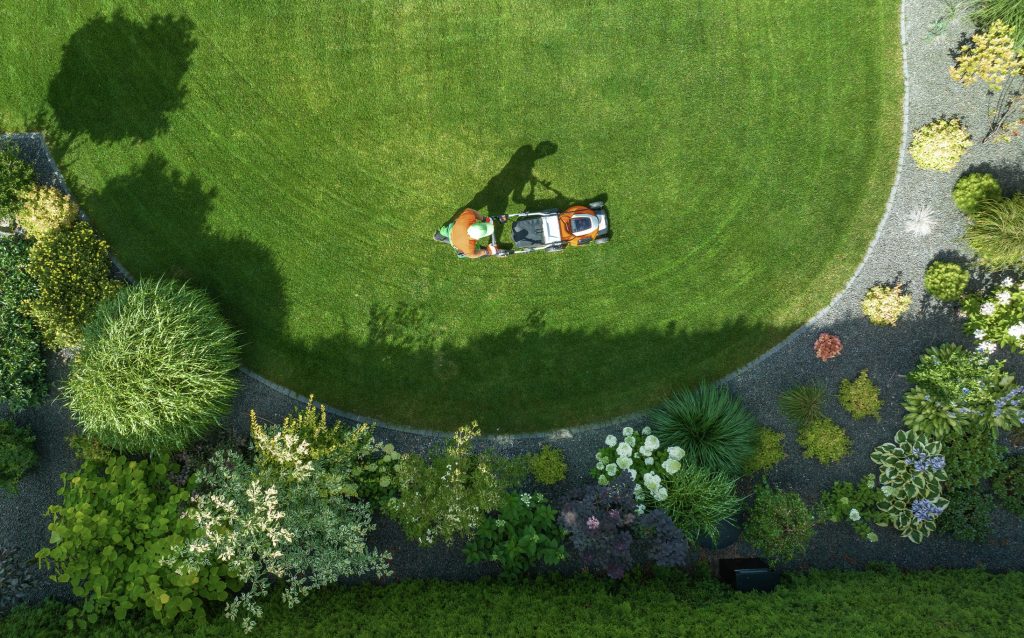
A lush, healthy lawn does more than improve curb appeal – it creates a space for relaxation, play, and connection. Whether you’re starting from scratch or reviving patchy grass, the key to lawn success is consistent care rooted in smart, seasonal decisions. From soil prep to watering, mowing, and fertilizing, this guide walks you through the essentials of lawn maintenance in Canada for every yard size and condition.
Start with the soil
Healthy grass starts below the surface. Begin by clearing away dead leaves, branches, and leftover clippings. If your lawn feels uneven or compacted, lightly rake and level out bumps.
Aeration is essential, especially in high-traffic zones or areas where water tends to pool. Aerating loosens the soil and allows oxygen, water, and nutrients to reach the roots, setting the foundation for strong growth.
Seed strategically
If your lawn looks thin or patchy, overseeding is a smart move. The best time for most Canadian climates is early fall, when conditions are cool, moist, and free from weed competition.
- Choose a grass seed mix suited to your region and sunlight exposure.
- Keep newly seeded areas evenly moist – not soggy – for several weeks.
- Morning watering is best to reduce evaporation and disease risk.
Water wisely
Let your lawn tell you when it’s thirsty. Instead of watering on a strict schedule, watch for signs of dryness: blades that curl, turn bluish-grey, or don’t spring back after being walked on. Water your lawn deeply and in the morning to reduce evaporation and give roots time to absorb moisture before the heat sets in. Always aim for about one inch of water per week, depending on your grass type and local rainfall.
Sprinkler systems or timed irrigation can help you water efficiently, saving both water and money, especially if your system is set up to target areas evenly and avoids run-off.
Fertilize with intention
Feeding your lawn properly helps it grow thick and vibrant.
- Look for slow-release fertilizers or step-based programs that feed over time instead of giving your lawn a sugar rush.
- If you’re sowing new grass, use a starter fertilizer that supports root growth and avoid using spreaders with hollow wheels, as they can leave ruts that disrupt seedlings.
- Over-fertilizing can scorch your lawn. Under-fertilizing leads to weak growth. The key is consistency and even application.
Mow with care
Cutting grass seems simple, but doing it wrong can do more harm than good.
- Never cut wet grass – it tears more easily and can clog your mower.
- Stick to the one-third rule: never cut off more than a third of the blade height. Ideally, mow when your grass is about four inches tall, cutting it back to three inches. This helps protect roots from sun damage and discourages weed growth.
- Keep mower blades sharp – dull blades rip the grass instead of slicing cleanly, which can lead to disease.
- Switch up your mowing pattern regularly to prevent soil compaction and ruts.
- Don’t scalp your lawn (cutting grass too short) in the hopes of mowing less – it shocks the plant and invites weeds.
Tidy the edges
Clean, crisp edges make a world of difference. Use a trimmer or edger along walkways, driveways, and garden beds. Not only does this make your lawn look professionally maintained, it prevents overgrowth from creeping into unwanted areas.
Watch for trouble
Brown patches can pop up even in a well-tended lawn.
- It could be dormancy. Grass will naturally go brown to conserve energy during extreme heat or drought. If it springs back after rain or watering, there’s no need to panic.
- Other culprits include fungal disease, pet urine, or poor drainage. Inspect the soil, remove any thatch buildup, and adjust watering habits if needed.
- Weeds? Spot-treat with a selective herbicide (not a total vegetation killer), and be careful not to overapply.
Final Thoughts
Lawn care doesn’t have to be overwhelming. Think of it like tending to any living thing: with the right foundation, consistency, and a willingness to observe and adapt, your lawn can become one of your home’s happiest features. Take the time to understand what it needs, season to season.





